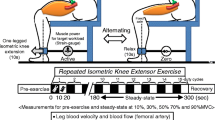Abstract
Leg compression devices have been used extensively by patients to combat chronic venous insufficiency and by astronauts to counteract orthostatic intolerance following spaceflight. However, the effects of elastic and inelastic leggings on the calf muscle pump have not been compared. The purpose of this study was to compare in normal subjects the effects of elastic and inelastic compression on leg intramuscular pressure (IMP), an objective index of calf muscle pump function. IMP in soleus and tibialis anterior muscles was measured with transducer-tipped catheters. Surface compression between each legging and the skin was recorded with an air bladder. Subjects were studied under three conditions: (1) control (no legging), (2) elastic legging, and (3) inelastic legging. Pressure data were recorded for each condition during recumbency, sitting, standing, walking, and running. Elastic leggings applied significantly greater surface compression during recumbency (20±1 mm Hg, mean±SE) than inelastic leggings (13±2 mm Hg). During recumbency, elastic leggings produced significantly higher soleus IMP of 25±1 mm Hg and tibialis anterior IMP of 28±1 mm Hg compared to 17±1 mm Hg and 20±2 mm Hg, respectively, generated by inelastic leggings and 8±1 mm Hg and 11±1 mm Hg, respectively, without leggings. During sitting, walking, and running, however, peak IMPs generated in the muscular compartments by elastic and inelastic leggings were similar. Our results suggest that elastic leg compression applied over a long period in the recumbent posture may impede microcirculation and jeopardize tissue viability. On the other hand, inelastic leggings do not compress leg tissues at levels above 20 mm Hg during recumbency. Therefore inelastic leggings may be more effective in improving venous circulation in the legs of patients with chronic venous insufficiency.
Similar content being viewed by others
References
Bevegård S, Lodin A. Postural circulatory changes at rest and during exercise in five patients with congenital absence of valves in the deep veins of the legs. Acta Med Scand 1962;172:21–29.
Dietlein LF. Summary and conclusions. In Johnston RS, Dietlein LF, Berry GA, eds. Biomedical Results of Apollo. Washington, DC: National Aeronautics and Space Administration SP 368, 1975, pp 573–574.
Convertino VA. Physiological adaptations to weightlessness: Effects on exercise and work performance. Exerc Sport Sci Rev 1990;18:119–163.
Thornton WE, Rummel JA. Muscular deconditioning and its prevention in spaceflight. In Johnston RS, Dietlein LF, eds. Biomedical Results from Skylab. Washington, D.C.: National Aeronautics and Space Administration SP 377, 1977, pp 191–197.
Thornton WE, Hoffler GW. Hemodynamic studies of the leg under weightlessness. In Johnston RS, Dietlein LF, eds. Biomedical Results from Skylab. Washington, D.C.: National Aeronautics and Space Administration SP 377, 1977, pp 324–329.
Watenpaugh DE, Buckey JC, Lane LD, et al. Human leg blood flow and compliance during spaceflight. Am Soc Gravit Space Biol Bull 1992;6:35.
Lewis CE, Antoine J. Elastic compression in the prevention of venous stasis. Am J Surg 1976;132:739–743.
Vernick SH, Shapiro D, Shaw FD. Legging orthosis for venous and lymphatic insufficiency. Arch Phys Med Rehabil 1987;68:459–461.
Stick C, Grau H, Witzleb E. On the edema-preventing effect of the calf muscle pump. Eur J Appl Physiol 1989;59:39–47.
Nehler MR, Moneta GL, Woodard DM, et al. Perimalleolar subcutaneous tissue pressure effects of elastic compression stockings. J Vasc Surg 1993;18:783–788.
Rydevik B, Lundborg G, Bagge U. Effects of graded compression on intraneural blood flow. J Hand Surg 1981;6:3–12.
Reneman RS, Slaaf DW, Lindbom L, et al. Muscle blood flow disturbances produced by simultaneously elevated venous and total muscle tissue pressure. Microvasc Res 1980;20:307–318.
Author information
Authors and Affiliations
Additional information
Supported by NASA grant 199-14-12-04.
We thank Drs. J. Bergan and J. Styf for helpful discussions, D. Chang for technical assistance, F. Shaw for supplying the leggings, and our subjects for their participation.
About this article
Cite this article
Murthy, G., Ballard, R.E., Breit, G.A. et al. Intramuscular pressures beneath elastic and inelastic leggings. Annals of Vascular Surgery 8, 543–548 (1994). https://doi.org/10.1007/BF02017410
Issue Date:
DOI: https://doi.org/10.1007/BF02017410




